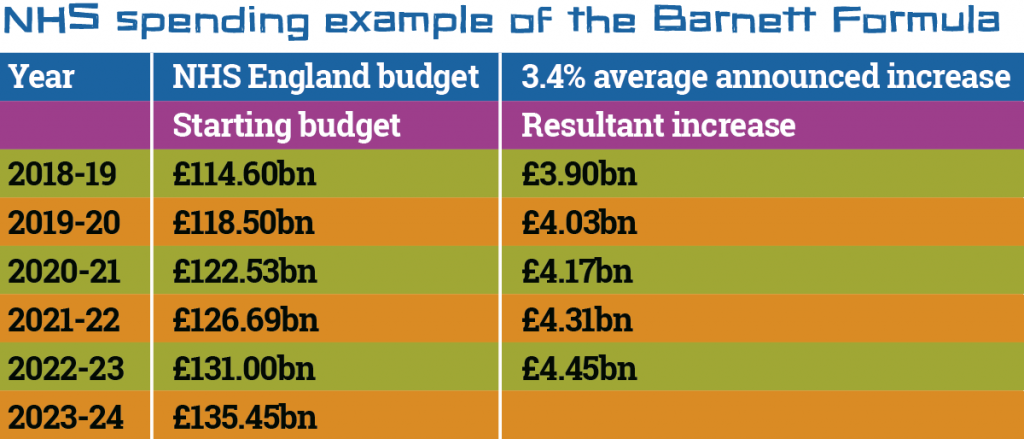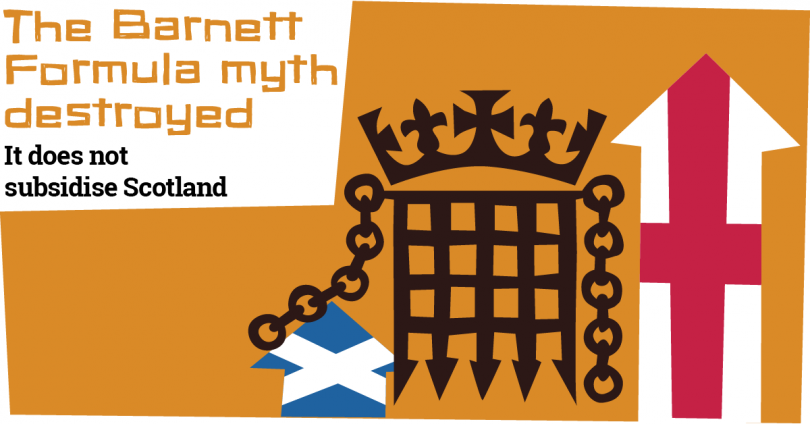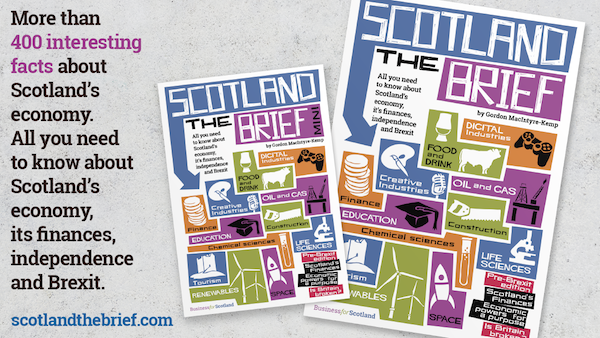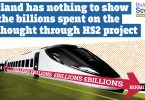Arguably the most misunderstood part of the UK public sector budgeting mechanism is the Barnett Formula. The vast majority of people, politicians and the media seem to think that Barnett represents a subsidy to Scotland. Many Westminster MPs (mainly Conservatives) have described it as English taxpayers subsidising Scottish public spending, and the mainstream media have run headlines along those lines. There is just one little problem with that idea – it’s complete and utter nonsense.
The Barnett Formula was introduced as a funding mechanism containing a mathematical formula that aimed to reduce Scottish funding in comparison to England’s. To understand why it exists, and how it was supposed to reduce Scotland’s public spending, we need to understand the Scotland of the 1970s, when it was first introduced.
The Barnett Formula’s predecessor, the Goschen Formula, had been used between 1889-1959 before budget negotiations by secretaries of state became the norm. Scotland was an industrial powerhouse and its economy and the public sector revenues generated meant that Secretaries of State for Scotland had real negotiating power in budget discussions.
The Barnett Formula was first devised in 1978 as a temporary response to the potential devolution of powers to a Scottish parliament after the 1979 devolution referendum and thus Barnett would replace the annual budget negotiations. The referendum result saw 51.6% of voters in Scotland voting for devolution. However, fearing what would happen, a Labour MP for an English constituency successfully tabled an amendment to the referendum act that stipulated that more than 40% of the total Scottish electorate would have to vote “Yes” in the referendum for devolution to be enacted. Even though the result was 51.6% Yes, the turnout was only 64%, so as a percentage of the total electorate only 32.9% voted Yes, and so despite winning the referendum, devolution was denied to the people of Scotland.
Fearing a collapse of influence in future budget negotiations, consecutive Scottish Secretaries of State argued to maintain the Barnett Formula, as they knew that, at least in the short term, it would maintain Scottish public sector spending at higher levels per head than in England. The Treasury, presumably understanding the mathematics of the formula knew that over time it would reduce real terms spending in Scotland to parity with English levels, was only too happy to agree.
If the Barnett Formula had succeeded and it reduced Scotland’s public sector spending down to parity with England’s, that would just mean that the Scottish surpluses we highlighted in our Accounting Trick article would have been higher than they were. Scotland would therefore have been even better of as an independent nation than in the figures we presented there. The reason that Scottish public spending remains higher to this day is largely due to unforeseen devolution complications and no other reason. That is why many Westminster politicians want to replace it, with a formula that would presumably be more effective at cutting Scotland’s budget.
So how does the Barnett Formula work?
Scottish public sector revenues are collected by the UK and Scottish Governments and sent to the UK Treasury. Spending Reviews take place normally over five year periods and when the Budget for England is completed, the Barnett Formula is applied. This aims to give each country the same pounds-per-person change in funding as the change in funding for comparable government services in England. Then, based on that calculation, the Scottish Government receives a block grant back from the treasury with which to fund the expenditure it is responsible for under devolution. This block grant is not in any way based on the needs of Scotland, or on the levels of revenue generated in Scotland.
The Barnett formula for Scotland at its simplest

It’s fairly simple and the comparability factor (purple box) is, again in simple terms, the percentage amount of the budget responsibility devolved to the Scottish Parliament. For example, Education is 100% devolved and so the comparability factor is 100%. In Defence spending, where Westminster makes all the decisions, the comparability factor is zero.
How it works in practice – Health
For example, the UK Government announced plans to increase spending on the NHS by an average of 3.4% in every year for the five year period starting with the 2018-19 and ending with the 2022-23 year. Now obviously, all of these planned budgets went out the window when COVID-19 hit and devasted the health sector, adding billions on to related costs – vaccines, PPE and the hideously expensive and unreliable UK Government track and trace system. However, the planned budget makes for a good case study.
So the increases in England’s health spending will be:

The Barnett Formula is then applied, which takes the increase in England and multiplies it first by the comparability percentage, which is the amount of funding for areas that are devolved and, in health, that is 99.4%. Then it multiples that figure by Scotland’s population share of England’s population, which is 9.85%
Thus, the resultant increases in NHS spending in Scotland from that spending review will be as follows.

In 2018/19 the spending on Scotland’s health budget would increase by £381 million. The increases will generate larger numbers every year because, although the rise will always be 3.4%, the base year will be larger than the year before.
Now, you might think that when England’s NHS budget rises by 3.4%, so should Scotland’s. However, the Barnett Formula was not designed to mean a rise in England’s spending would be passed on in percentage terms in Scotland. That would be such a simple calculation it would hardly need a formula or a fancy name.
So let us see what happens if The Barnett Formula just give Scotland’s NHS budget the same percentage increase as England is getting as a result of the review – namely 3.4%.

As you can see, the Barnett Formula doesn’t pass on the full 3.4%. In fact, over the five year period, the cumulative increase in Scotland’s budget under the Barnett formula is £2.042 billion, but if the English percentage increase was applied the cumulative budget improvement would have been £2.39 billion, a whole £343 million higher across the five years. 456
Let’s be clear, the Barnett Formula means that in the budget areas where it applies, spending in Scotland is reduced on a percentage basis in comparison to the increases received in England.
Why does this happen? Well, Scotland’s Health budget per head is larger than England’s (it always has been) and so the per-head calculation means the increase overall will result in a smaller percentage increase in total budget in Scotland. This is known as the “Barnett Squeeze” and proves that the Barnett Formula has a built-in mechanism to lower Scottish Government spending till it reaches parity with England’s.
Should Scotland’s health budget be higher per head than England’s? Well, given Westminster has run a policy of de-industrialisation and financialisation, causing population growth to be slower in Scotland (and indeed the other smaller home nations) then you have fewer people, lower population density and an ageing population and higher levels of poverty. Then there is a justifiable need to spend more. Add to that the fact that as proven in our ‘Accounting Trick‘ article, Scotland, in reality, subsidises the rest of the UK, it seems a bit dishonest to devise a formula to cut that vital health spending and then tell the Scottish people that the formula is a boost or a bonus to their nation which they can’t afford to live without.
The Barnett Formula has the same impact across many of Scotland’s most important spending areas but let’s finish by considering the real-world impact to Scotland’s Health spending by illustrating what that missing £343 million of budget increases denied to Scotland’s NHS across the five years would pay for.
If Scotland were to have received the full 3.4% increase (as in England) then looking at the average of the salary ranges (published in April 2019) for medical staff the Scottish NHS would have been able to hire: 457
- 972 new GPs in 2018/9
- 3,756 new Health Care Assistants in 2019/20
- 750 additional Consultant Doctors in 2020/21
- 1,447 Nurse Consultants in 2021/22
- 1,030 Consultant Paramedics in 2022/23
Conclusion
In stark terms, the Barnett Formula, if COVID-19 hadn’t happened, would have withheld from Scotland enough money to have hired approximately 7,955 additional NHS medical professionals, over the five years covered by the spending review. That is not a bonus – it’s a smoke and mirrors mechanism that aims to reduce the Scottish Government’s spending power in real terms.
.










Sadly the myth is so embedded in the psyche of unionists wherever they reside to make protestations to the contrary almost irrelevant! I say ‘almost’ because this lie (for that is what a myth is) needs to be exposed, talked about time and again and to the extent of boring anyone that seeks to assert it as truth; thank you Gordon
So should the Barnett formula be withdrawn ASAP?
Thanks. The conclusion that Scotland puts into the British GDP more than it takes out has to be presented as simply and as lucidly as possible, albeit with minimum of vital facts to support. That done, it is for the SNP to disseminate and ‘soberly’ – crucial here – flaunt. At the moment they are enjoying exceptional cross party respect throughout the whole of the U.K. Remember how Wilson sold Common Market membership in 1975? By presenting facts and carefully positing conclusions, thereby winning over many Eurosceptics. The SNP should do like wise. Potential gold dust this report.
It would be worth pointing out that the Barnett Formula is applied to London Weighting, is applied to both planned capital and revenue expenditure and that no Govt spending programme or spending authority accounts for expenditure at transaction level according to which UK territory it is spent In or benefits. The figures used by HM Treasury are totally unreliable for all UK territories particularly as they relate to England.
Is there a “printer-friendly” version/PDF of this article? (And all the other ones that you’ve published since the booklets were released?) I know of people who are asking for printed copies of this article for handouts.
We have published the finance the Truth content in our boo Scotland the Brief and most Yes groups have copies. As for making a PDF for each article, no because they tend to be too long to easily print and they are accessible online. We will do PDF versions of Our Indy FAQ series as those are designed to be short and punchy and accessible to print.
Keith Brown and his rebuttal unit need to get on board with this. I noticed on an earlier Question Time, Fiona Bruce kept cutting across Joanna Cherry, when she was developing rebuttal points, but we must insist and persist until the British and English nationalists are put in their place.
Thanks again Gordon for vital piece of work.
Thank you for this. I spent my youth in London being told how much Scotland is subsidised by Westminster. In a recent discussion group here in Spain I was attacked on all sides by daring to suggest that an Independent Scotland could survive. Better to have the facts at my finger tips next time!
“the NHS would have been able to hire: 388”?
Presumably that is a typo and I’m not just being as thick as mince?
The numbers are linked to a page with more than 400 sources and links to reports we have used to source the data used in the blog – they usually appear at the end of sentences but that’s one is a bit awkward as it’s at the start of the list. We are just using the links to prove that we are right.
Perhaps the general public should be made aware of the facts?
Brilliant piece of ammunition for conversations on the doors
Hi Gordon – there is some kind of formatting problem on the page. The images do not show in Mozillla Firefox, clicking “view image” leads to a message about wrong MIME type.
In Microsoft Edge, it’s not even obvious there are supposed to be pictures there.
We have looked into this and tested it on multiple devices and it works for us. The site is also mobile and iPad tested too and we even checked the image formats – sorry no idea why you are having issues.
I use Firefox and I have no issues. The page renders perfectly for me. It’s also fine in MS Edge for me. Perhaps you have a local problem?
Great piece. You’re winning the economic argument, forcing the unionist reactionaries onto the back foot at every turn.